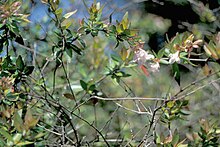Abelia × grandiflora
| Abelia × grandiflora | |
|---|---|

| |
| Scientific classification | |
| Kingdom: | Plantae |
| Clade: | Tracheophytes |
| Clade: | Angiosperms |
| Clade: | Eudicots |
| Clade: | Asterids |
| Order: | Dipsacales |
| Family: | Caprifoliaceae |
| Genus: | Linnaea |
| Species: | L. × grandiflora
|
| Binomial name | |
| Linnaea × grandiflora (Rovelli ex André) Christenh.[1]
| |
| Synonyms[1] | |
| |
Linnaea × grandiflora, synonym Abelia × grandiflora, is a hybrid Linnaea, raised by hybridising L. chinensis with L. uniflora. It is a deciduous or semievergreen multistemmed shrub with rounded, spreading, or gracefully arching branches to 1.0-1.8 m tall. The leaves are ovate, glossy, dark green, and 2–6 cm long. The flowers are produced in clusters, white, tinged pink, bell-shaped, to 2 cm long. Unlike most flowering shrubs in cultivation, the species blooms from late summer to well into the autumn.
The Latin specific epithet grandiflora means "abundant flowers".[2]
Cultivation and uses
Linnaea × grandiflora was first raised in 1886 at the Rovelli nursery at Pallanza (now Verbania), on Lake Maggiore in Italy. It is used as an ornamental plant in specimen plantings in gardens, or in a mixed border with other shrubs. Propagation is by cuttings. The variegated cultivar 'Hopleys/[3] growing to 1.5m × 1.5m, has gained the Royal Horticultural Society's Award of Garden Merit.
References
- ^ a b "Linnaea × grandiflora (Rovelli ex André) Christenh.". Plants of the World Online. Royal Botanic Gardens, Kew. Retrieved 2018-01-22.
- ^ Harrison, Lorraine (2012). RHS Latin for Gardeners. United Kingdom: Mitchell Beazley. ISBN 184533731X.
- ^ "Abelia × grandiflora 'Hopleys' (PBR) (v)". Royal Horticultural Society. Retrieved 20 December 2017.
This article includes a list of references, related reading, or external links, but its sources remain unclear because it lacks inline citations. (February 2009) |
- Bailey, L. H. (2005). Manual of Gardening (Second Edition). Project Gutenberg Literary Archive Foundation.
- Template:Pt icon Lorenzi, H.; Souza, M.S. (2001) Plantas Ornamentais no Brasil: arbustivas, herbáceas e trepadeiras. Plantarum ISBN 85-86714-12-7.
